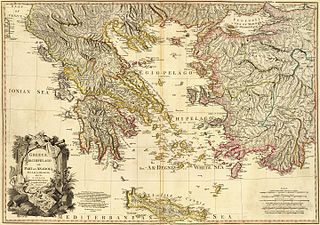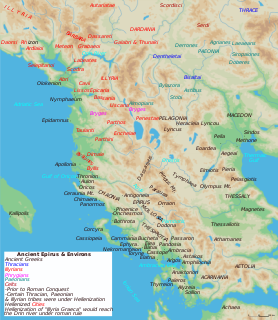 W
WThe Agrianes or Agrianians, were a tribe whose country was centered at Upper Strymon, in present-day western Bulgaria, and also held areas of southeasternmost Serbia in the ancient Roman provinces of Dacia Mediterranea, at the time situated north of the Dentheletae. In the times of Philip II, the territory of the Agrianes was administered by Pella. They were crack javelin throwers and an elite unit of Alexander the Great's light infantry, who fought under the command of General Attalus.
 W
WAlmopians or Almopes were an ancient Paeonian tribe. They inhabited the region of Almopia in Lower Macedonia, which was named after the tribe. According to the Greek mythology, the founder of the tribe was thought to be the Giant demigod Almops whom they highly worshiped.
 W
WBottiaea was a geographical region of ancient Macedonia and an administrative district of the Macedonian Kingdom. It was previously inhabited by the Bottiaeans, a people of uncertain origin, later expelled by the Macedonians into Bottike (Chalcidice). In Roman times it was replaced by Emathia as a geographical term.
 W
WBryges or Briges is the historical name given to a people of the ancient Balkans. They are generally considered to have been related to the Phrygians, who during classical antiquity lived in western Anatolia. Both names, Bryges and Phrygians, are assumed to be variants of the same root. Based on archaeological evidence, some scholars such as Nicholas Hammond and Eugene N. Borza argue that the Bryges/Phrygians were members of the Lusatian culture that migrated into the southern Balkans during the Late Bronze Age.
 W
WCrestonia was an ancient region immediately north of Mygdonia. The Echeidorus river, which flowed through Mygdonia into the Thermaic Gulf, had its source in Crestonia. It was partly occupied by a remnant of the Pelasgi, who spoke a different language from their neighbors ; later the Greeks.
 W
WThe Dardani were a Paleo-Balkan tribe, which lived in a region which was named Dardania after their settlement there. The eastern parts of the region were at the Thraco-Illyrian contact zone. In archaeological research, Illyrian names are predominant in western Dardania, while Thracian names are mostly found in eastern Dardania. Thracian names are absent in western Dardania; some Illyrian names appear in the eastern parts. Thus, their identification as either an Illyrian or Thracian tribe has been a subject of debate; the ethnolinguistic relationship between the two groups being largely uncertain and debated itself as well. The correspondence of Illyrian names - including those of the ruling elite - in Dardania with those of the southern Illyrians suggests a "thracianization" of parts of Dardania. Strabo in his geographica mentions them as one of the three strongest Illyrian peoples, the other two being the Ardiaei and Autariatae.
 W
WThe Derrones were a Thracian or a Paionian tribe. Our knowledge of them comes from coins bearing variations of the legend of DERRONIKON (ΔΕΡΡΟΝΙΚΟΝ) - DERR (ΔΕΡΡ). The letters used in the coins are Greek, although this does not prove that the Derrones spoke the same language as their southern neighbours. These coins, which were perhaps made for export as much as for internal trade, are traditionally dated to 500–450 BC.
 W
WThe Dorians were one of the four major ethnic groups among which the Hellenes of Classical Greece considered themselves divided. They are almost always referred to as just "the Dorians", as they are called in the earliest literary mention of them in the Odyssey, where they already can be found inhabiting the island of Crete.
 W
WEordaea was an ancient kingdom and later an administrative region of the kingdom of Macedon. It was part of the ancient geographical region of Upper Macedonia and was located south of Lynkestis, west of Emathia, north of Elimiotis and east of Orestis. The modern province and municipality Eordaia were named after the ancient kingdom and region.
 W
WEordaea was an ancient kingdom and later an administrative region of the kingdom of Macedon. It was part of the ancient geographical region of Upper Macedonia and was located south of Lynkestis, west of Emathia, north of Elimiotis and east of Orestis. The modern province and municipality Eordaia were named after the ancient kingdom and region.
 W
WMycenaean Greece was the last phase of the Bronze Age in Ancient Greece, spanning the period from approximately 1600–1100 BC. It represents the first advanced and distinctively Greek civilization in mainland Greece with its palatial states, urban organization, works of art, and writing system. The most prominent site was Mycenae, in the Argolid, after which the culture of this era is named. Other centers of power that emerged included Pylos, Tiryns, Midea in the Peloponnese, Orchomenos, Thebes, Athens in Central Greece and Iolcos in Thessaly. Mycenaean and Mycenaean-influenced settlements also appeared in Epirus, Macedonia, on islands in the Aegean Sea, on the coast of Asia Minor, the Levant, Cyprus and Italy.
 W
WThe Molossians were a group of ancient Greek tribes which inhabited the region of Epirus in classical antiquity. Together with the Chaonians and the Thesprotians, they formed the main tribal groupings of the northwestern Greek group. On their northern frontier, they neighbored the Chaonians and on their southern frontier neighbored the kingdom of the Thesprotians. They formed their own state around 370 BC and were part of the League of Epirus. The most famous Molossian ruler was Pyrrhus of Epirus, considered one of the greatest generals of antiquity. The Molossians sided against Rome in the Third Macedonian War and were defeated. Following the war, 150,000 Molossians and other Epirotes were enslaved and transported to the Roman Republic, overwhelmingly in Italy itself.
 W
WPelagonia is a geographical region of Macedonia named after the ancient kingdom. Ancient Pelagonia roughly corresponded to the present day municipalities of Prilep, Mogila, Novaci, Kruševo, and Krivogaštani in North Macedonia.
 W
WThe name Pelasgians was used by classical Greek writers to refer either to the ancestors or forerunners of the Greeks, or to all inhabitants of Greece before the emergence or arrival of Greeks aware of their Greekness. In general, "Pelasgian" has come to mean more broadly all the indigenous inhabitants of the Aegean Sea region and their cultures, "a hold-all term for any ancient, primitive and presumably indigenous people in the Greek world".
 W
WThe Thracians were an Indo-European people who inhabited large parts of Eastern and Southeastern Europe in ancient times. They spoke the Thracian language and shared a common culture. The study of the Thracians is known as Thracology.
 W
WThe Molossians were a group of ancient Greek tribes which inhabited the region of Epirus in classical antiquity. Together with the Chaonians and the Thesprotians, they formed the main tribal groupings of the northwestern Greek group. On their northern frontier, they neighbored the Chaonians and on their southern frontier neighbored the kingdom of the Thesprotians. They formed their own state around 370 BC and were part of the League of Epirus. The most famous Molossian ruler was Pyrrhus of Epirus, considered one of the greatest generals of antiquity. The Molossians sided against Rome in the Third Macedonian War and were defeated. Following the war, 150,000 Molossians and other Epirotes were enslaved and transported to the Roman Republic, overwhelmingly in Italy itself.